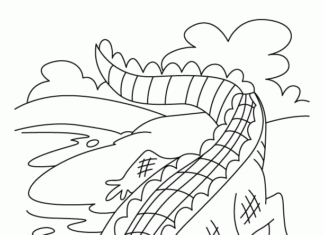Alligators are a large family of reptiles in the order Crocodilians. They are aquatic animals, mainly associated with tropical and subtropical environments.
Alligator Coloring Pages
information
- Differences between alligators and crocodiles: Alligators and crocodiles are two different families of reptiles, although they are related. The main differences between them are head shape and behavior. Alligator heads tend to be wider and shorter, while crocodiles have longer and pointed snouts. Alligators tend to be more shallowly submerged in water, while crocodiles are more likely to extend their noses above the surface of the water.
- Geographical distribution: Alligators are mainly found in North and South America. There are two main species in North America: the American alligator (Alligator mississippiensis) and the Chinese alligator (Alligator sinensis). South America is home to the black alligator (Melanosuchus niger).
- Life expectancy: Alligators can live quite long in the wild. Depending on the species and living conditions, their life span can be as long as 35-50 years.
- Diet: Alligators are carnivores, feeding mainly on fish, amphibians, water birds and small mammals. Their diet can vary depending on the availability of food in a particular area.
- Physical characteristics: Alligators have strong jaws equipped with numerous conical teeth that regenerate throughout their lives. They have a well-adapted body for life in water, with a long tail and elongated paws.
- Reproduction: Female alligators lay their eggs on the banks of bodies of water in cavities or nests made of plants. After the eggs hatch, the mother helps the young alligators get into the water and takes care of them for a while.
- Protection and threats: Some alligator species are considered endangered and are protected by law. In the past, alligator populations have been extremely endangered due to hunting for skins and meat, but many places have succeeded in implementing effective conservation programs.
- The role of the ecosystem: Alligators play an important role in the ecosystem as predators that regulate populations of other animals. Their presence can affect the behavior of other aquatic and terrestrial species.
- Culture and symbolism: Alligators play an important role in the folklore, mythology and culture of some communities, especially those that live close to their natural habitats.
trivia
- Unique jaw design: Alligators have jaws that are ideally suited to their lifestyle. The upper jaw matches the lower jaw, so that the teeth of the upper jaw overlap the teeth of the lower jaw, which helps them retain prey while foraging.
- Thermoregulation: Alligators are variably warm animals, which means they can regulate their body temperature depending on their environment. This allows them to adapt to different weather conditions.
- Speed in water: Despite their massive appearance, alligators can reach astonishing speeds in water. Some sources say they can swim as fast as 32 km/h.
- Simultaneous breathing: Alligators are reptiles that can breathe both atmospheric air and through their lungs in water. This allows them to maintain a constant gas balance in their bodies.
- Audio communication: Alligators can make various sounds, including distinctive hisses, burps and other noises. These are used to communicate with each other, especially during mating season.
- Leather and leather manufacturing: Alligator skin is exceptionally valued for its durability and unique pattern. In the past, alligators were hunted mainly because of the value of their skin, which had the effect of endangering some populations.
- Small number of teeth: Despite their fearsome appearance, alligators have relatively few teeth. They usually have about 74-80 teeth, and when one tooth falls out, it is replaced by a new one throughout their lives.
- Diet composition: The diet of alligators varies depending on their age. Younger individuals are more likely to eat insects, fish and small animals, while older alligators may hunt larger mammals and water birds.
- Size and weight: Alligators vary in size depending on the species. The American alligator can reach 2 to 4.5 meters in length, while the black alligator, found in the Amazon, can reach up to 6 meters in length.
- Role in the ecosystem: Alligators play an important role in the ecosystem as predators that control populations of other animals, such as fish and small mammals. Their presence affects the behavior and structure of other aquatic and terrestrial species.






